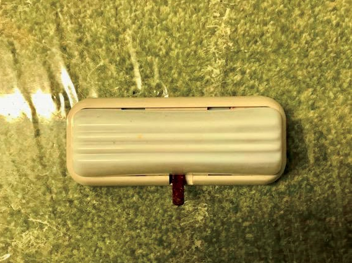MGB – To B or not to B?
Chapter 8
![]()
Chapter 8
MGB Interior – Dashboards
The MGB interior started life as a very basic but practical and functional space with all the dials set out just where you would expect them, in view when driving so as not to distract yourself from the road ahead, switches simply placed along the centre section of the dashboard all in an orderly fashion.

LHD USA Dashboard
The only exception to this was the overdrive switch which on the early cars was placed on the right- hand side of the dashboard near the fuel gauge which worked perfectly well but did look like an afterthought compared to the rest of the layout.
As for the actual interior trim, seat design and trim panels, these varied a lot over the years and much of this was influenced by fashion and the era they were produced: from the basic pretty leather seats with contrasting piping, in the early 60’s cars to the somewhat bold orange deck chair style seats that adorned the late 70’s MG’s.
Like many other areas of the MGB, everything was based around the same basic design and shape, so just like the exterior changes that were made, while still keeping the lines of the original, the dashboard always kept the same rough size and shape on the UK models, through more and more features were added to keep things fresh and appealing to the MGB followers.
Nothing radical really happened, as this would have cost far too much to develop and manufacture, constant subtle enhancements were made and from the four main dashboard designs to the 3 seat changes the core of it all remained very MGB. The dashboard for the North American market however was very different: from the MK2 version with the padded recessed dash layout, the actual dashboard was set back several inches set back towards the windscreen, it was a metal dashboard covered in a padded sponge and covered in plastic to help absorb any potential impact during a crash.
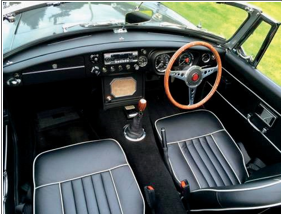
Dashboard layout of the original Mk1

Close-up image of crash rail
All UK cars were fitted with a crash rail in front of the dashboard and ran the full width of the car. The post-1967 US cars were the exception to this, with their recessed plastic pillow. The finish of the UK dashboards was in a crinkle matt finish and suited the low-key design of the early cars, this was maintained throughout the years with only slight changes in the crinkle finish, the very late style dash from 1976 onwards was mainly plastic with a small portion of metal showing, which was more of a flat black finish than a crinkle finish.
As you ease into the driving seat of an early MGB Roadster, the first thing you are drawn to are the two large gauges placed directly in the driver’s view which are the speedometer and tachometer. The other two gauges sat further left and right with the fuel gauge over to the far right of the dashboard and the dual gauge on the left keeping you up to date on the engine oil pressure and engine temperature.
The cars were fitted with Jaeger gauges at the beginning of production and in October 1964 were replaced with Smiths gauges.
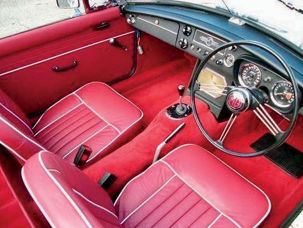
Close-up image of crash rail
The indicator stalk was a fragile-looking item that also operated the headlight flasher with the main beam function being located in the driver’s foot well, left of the clutch pedal.
The switches on the dashboard included a light switch for the side and headlights, a wiper switch, a heater motor switch, the overdrive switch, and a rheostat, between the speedo and rev counter (,) that enabled you to control the illumination of the instruments from dim to really dim. The ignition switch was placed on the dash as well as the choke cable. The heater controls that could regulate the amount of heat as well as the direction by the two black plastic controls along with the windscreen washers were set out neatly on the dashboard, as you go further across there was a glove box with a chrome strip along the front, and a key-operated lock, Nearest the door was a dome-shaped chrome map reading light with a switch above to operate, this would only work with the side or headlights switched on. There was nothing on the dashboard that wasn’t needed, and it did then and still does now, seem to flow as most switches fall to hand. The dashboard also had a large rectangular aperture that was fitted with a 3-piece blanking plate that could be removed if a radio was to be fitted, with the option of a single speaker going behind the console sitting on top of the tunnel.
The large 3-spoke steering wheel dominated much of the interior and also took up a lot of the legroom as you slide yourself into the car, the large steering wheel making manoeuvring at slow speed a much easier task.
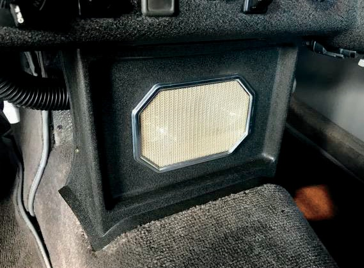
Early Radio speaker console
The next generation of dashboards took nearly ten years after the initial MGB launch to come about. And they had the same basic shape and layout, the biggest change was the style of switches, with the gauges all staying in the same place and the heater controls, the flick switches were now gone and replaced with a rectangular shaped rocker switch. The ignition was also deleted from the dashboard and moved to the steering column which freed up room for an additional switch if needed, many had a blanking plate fitted, this gave the option to fit spotlights or any additional electrical items that needed a switch or in the case of the GT a heated rear screen.
The next generation of dashboards took nearly ten years after the initial MGB launch to come about. And they had the same basic shape and layout, the biggest change was the style of switches, with the gauges all staying in the same place and the heater controls, the flick switches were now gone and replaced with a rectangular shaped rocker switch. The ignition was also deleted from the dashboard and moved to the steering column which freed up room for an additional switch if needed, many had a blanking plate fitted, this gave the option to fit spotlights or any additional electrical items that needed a switch or in the case of the GT a heated rear screen.
needed a switch or in the case of the GT a heated rear screen.
The radio hole is now used for fresh air vents that allow cool air in when the car is moving which could be angled to a position to suit the driver and passenger or completely blanked off if not required. The radio would now be positioned in the revised centre console below the dashboard that incorporated an armrest and cubbyhole for small items to be hidden from sight.
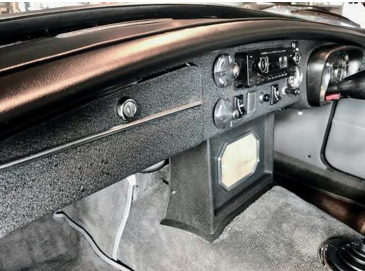
MK2 rocker switch dashboard
The third dashboard fitted to the MG was a more radical revision, and the first thing you notice is that the speedo and tacho are now smaller, 80mm in size instead of the 100mm on the earlier cars. The switches remained rocker style, but not as many were needed as the wiper switch could now be found on a stalk with the indicator on the other side.
The dashboard itself was a wider design around the column to allow for the extra room needed. This dash appeared in September 1974 but was introduced earlier in 1973 for the V8 model from which the dashboard was borrowed. The centre console and armrest remained the same, with the console still home to the radio and interior light, along with a cigar lighter, hazard switch and also the heated rear screen switch for the GT model.
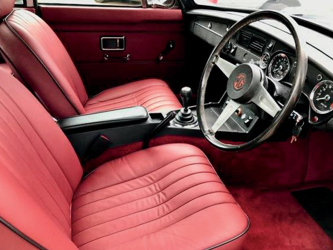
MK2 rocker switch dashboard
The final makeover for the dashboard began in June 1976 for the 1977 model cars, this was a complete overhaul of the dash layout, not only was the crinkle finish of the metal dash gone but in came more plastic and a new style of switches throughout.
The Speedo and Rev. Counter remained 80mm in size but were changed and were without the chrome bezel we were used to seeing, now they were in a matt black finish. The dual gauge was also dropped in favour of using a separate gauge for both, with the oil pressure in the original dual gauge position and the water temperature on the far right. The fuel gauge was now positioned in the middle of the two main gauges, surrounded by the indicator lights, the ignition and high beam warming light. The fresh air vents remained but the switches that operated the heater motor, hazard lights, and interior lights were a smaller design. The new style switches each had their own illumination when the lights were in use so were easier to find in the dark. The headlight switch was located on the steering column on the right-hand side close to the ignition switch.
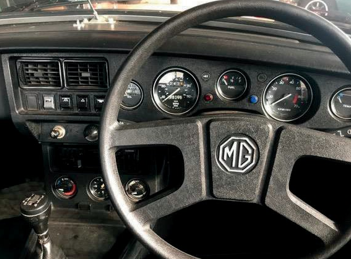
Later style dashboard
The centre console was re-arranged as it now had the heater controls which again were illuminated along with a time clock, two small rectangular warning lights sat at the bottom of the console one a seat belt warning light and the other a brake light warning. The radio aperture finished off the new console that was smaller than the previous as the new dash layout came further down, so in-between the main dash and console was a further plastic
section for the choke, cigar lighter, and a round interior light.

Later-style centre console
The glove box was a locking style but it could now be opened by simply pushing the button so no need for a key each time you wanted to reach for your driving gloves and sunglasses!
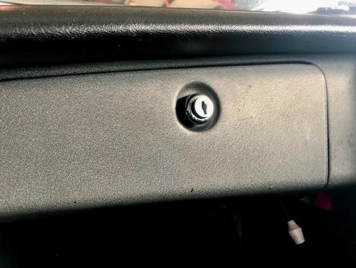
Glove box on later cars
MGB Seats
The first seats used were all made of leather with no headrest option available, these seats had limited movement as no tilt provision was fitted and the actual seat back foam was rather thin but surprisingly comfortable. The “H” style pattern which was piped into the seats defined the fluted areas nicely and was matched to the simple piping design on the door cards and trim panels.
Two rows of piping ran through the car on the trim kit and this was supplied in PVC to match the leather seats. When the MGB was initially introduced 3 interior colours were offered; Black, Red, and Blue. Another unique feature of the early cars was that the seats had a carpet section on the rear portion which ran through until 1968.

Early-style seats
The initial design of seats was used from 1962 until 1968. The next style used was only fitted for one year, it was a similar-looking seat that could recline but again had no headrest option and the fluting ran horizontally through the middle section as opposed to vertically on the earlier cars seats.
A silver handle was fitted for the recline function, and a black knob was used to operate the tilt, which would allow the seat to fold fully forward to give access to the rear, and it would also lock in place when pushed back upright, and a black knob was used to operate the tilt. For this model year, you could have the seats in either black or mushroom colour, but this shade is very rare, and only a few cars were ever supplied in this shade. All seats today are supplied in black if you are keeping the car original to the year.
In the USA this seat was used but came with a headrest, with a two-pole fitment, and this again is relatively rare, I have seen a few cars with this as some have found their way to the UK.
The third style of seats came in vinyl, as the luxury of leather is now gone since British Leyland became involved. From 1970 – 1972 and 1970 only for the GT, the reclining seats had a basket weave design for the fluted centre section and an all-plain vinyl outer panel. The colour range was expanded and ochre, navy blue, and autumn leaves were added, it was at this point that headrests were available and these were a large ‘D’ shape that fitted into the seats with a single rectangular pole.
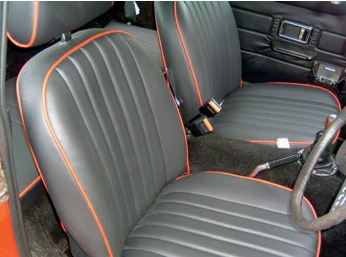
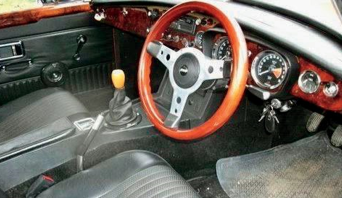
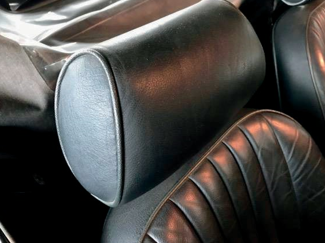
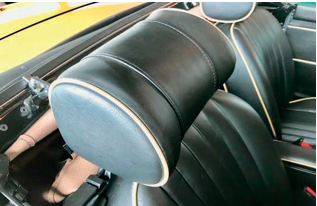
Smaller headrest
The MGB GT was trimmed with a different style to the Roadster and the 1971-1972 seat covers had the plain outer panels of the Roadster, with centre section was again fluted but with brushed nylon. There were small differences again for the 1973- 1976 seat covers as the GT version had brushed nylon material, with double stitching on the outer and across the centre panels. In 1974 the colours navy blue and ochre were dropped from the line-up.
The Roadster seats for 1973-1976 had embossed panels in the centre but with heat welded stitching across these and the outer panels.
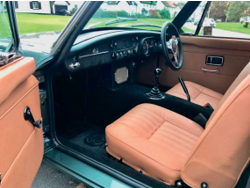

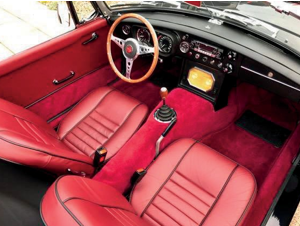
Yet another style of seat
The final seat design was what we all affectionately refer to as the deck chair style; these were fitted to both GT and Roadster models from 1976 through 1980 and were offered in silver and grey, or bold orange and brown. The actual design of the stripes is different on the two colour options, as the thickness of the stripes changed. The seats now come with the headrests as a standard fitment instead of an optional extra.
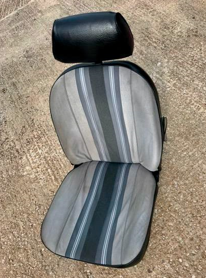
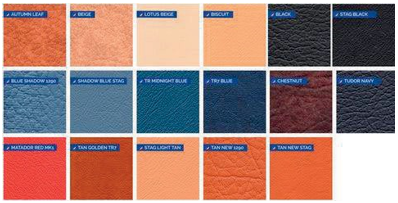
| 1962-1968 |
Black, Red, White, Blue Red black, white |
| 1969 | Black, Black Mushroom |
| 1970 | Black / Autumn leaf |
| 1971 | Black / Autumn leaf |
| 1972 | Black / Navy blue / Autumn leaf |
| 1973 | Black / Navy blue / Ochre |
| 1974 | 76 Black / Ochre |
| 1976 | 80 Silver, Grey / Brown, Orange |
| 1976 | 78 LHD cars Black / Autumn leaf |
| 1978 | 80 LHD cars Black / Beige |
The colours used were popular at the time of production; this shows how trends have changed over the years and an insight into how fashion and colours influenced carmakers. Today not many manufacturers would be brave enough to offer orange-striped seats and many MGB owners are taking a more modern twist on colours when considering trimming their beloved MG. With so many options now on offer the possibilities are considerably greater, look at this one Grey/White
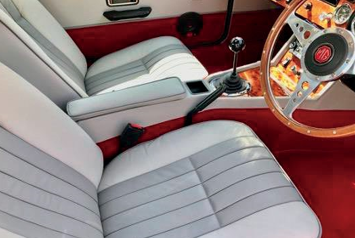
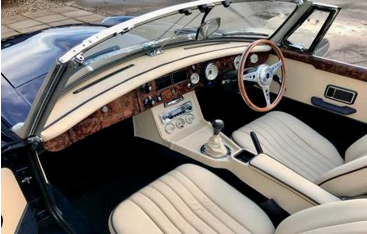

MGB carpets
|
The factory carpet colours |
||||
|
Year |
Colours |
Model |
||
|
1962- 1967 |
Black, Blue, |
Red, |
Roadster GT |
and |
|
1969 |
Black, Brown, |
Roadster GT |
and |
|
|
1970 |
Black |
Roadster GT |
and |
|
|
1971 |
Black, leaf |
Autumn |
Roadster GT |
and |
|
1972 |
Navy, leaf |
Autumn |
Roadster GT |
and |
|
1973 |
Navy, Ochre |
Roadster GT |
and |
|
|
1974 – 1976 |
Black, leaf |
Autumn |
Roadster GT |
and |
|
1977 – 1980 |
Black |
Roadster GT |
and |
|
Carpet kits for the MGB were always in the same colour as the trim and the main change with the carpets was the changeover to a 4 synchro gearbox tunnel, the tunnel carpet was altered as the shape of the tunnel changed, and the foot well carpets were made slightly narrower as the tunnel width expanded, however the rear section covering the battery tray and rear wheels arches all remained the same shape. The sill sections were covered in rubber, not carpet until 1975, when they were fully carpeted throughout but you will find most carpet sets available now. The GT carpet set had a different design for the rear wheel arches as they extend into the boot area along with a larger rear boot floor covering and two extra sections that fitted in the panels behind the rear lights.
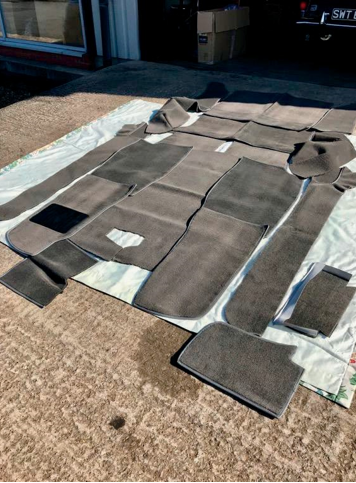
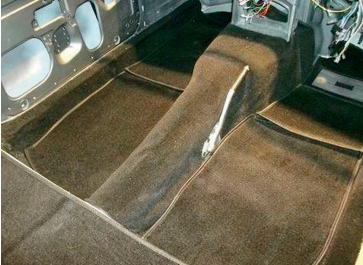
MGB Interior Trim Kits
As mentioned before the interior window winders, door openers, and locks all changed through the years and so the interior door cards were altered to fit the changing door furniture. The designs of the trim kit which includes the door panels and footwell panels along with the rear panels that extend over the wheel arch sections form part of the MGB trim kit. The main changes were all centred around the door panels as these seem to be the only items that changed significantly over the years.
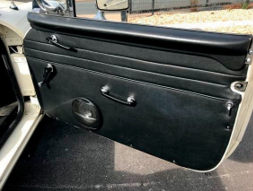
Early style door card.
The original door cards fitted in 1962 were a very basic design with one row of piping and a small cut- out for the door lock. They were attached to the door itself using screws with cup washers. The same style of door cards was used on all pull-handle models and revised in 1965 when the change to push-button doors happened and the GT was introduced.
The door panels for the GT were given an extra row of piping whereas the Roadster still had one row. Again the doors were redesigned and the internal door openers changed to the rectangular shaped version so the door panel had to be altered to suit now two rows of piping for both Roadster and GT, along with the fitting of the door panels now by hidden clips that attached to the door trim and pushed into pre-drilled holes in the door casing.
This style ran from 1968 – 1970 when an attempt to update the interior and the piping itself was removed being replaced with feature lines that were heat-formed and the bottom section had vertical flutes, only black was available in 1970 alteration.
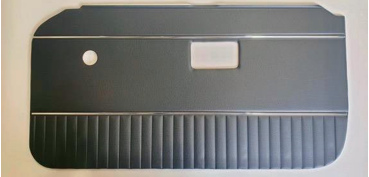
Door card with larger internal door opener and fluting at the bottom
The year 1971 saw the use of a similar design to the 1970 car but with 2 plastic chrome look strips running the length of the door card but the vertical fluting remained and additional colours of Navy blue, Ochre, and Autumn leaf along with the standard black were offered for both GT and Roadster cars. The final trim kit and door card revision was in the 1976 – 1980 models with the fluting at the bottom removed and the plastic chrome strips deleted. Now with a large circular shape where the window winder fits and markings for the bigger style door pull, and rectangle detailing was added, these were only available in black for the UK market however the North American cars had the option of Autumn leaf as well as a beige colour but the style remained the same.
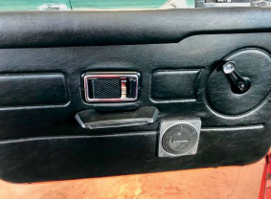
Doors and Fittings
The door capping’s were all fitted in black until 1970. The Mk1 door capping’s had a unique style and were specific to this model as they had an added padded section that was very similar to the crash rail that sat above the dashboard and made the cockpit flow around. These were used from 1962 until 1965 and came in either of these, black/black piping, black/red piping, black/white piping, or black/blue piping depending on the trim and body colour.
The door capping’s for 1965 became flatter and without the additional padded top section, and the GT capping was nearly identical with a slightly different shape on the back as it seated differently to the door and the door capping finishers which attaches the capping to the door itself is also a different shape. The final capping design from 1970 was similar to the previous one but was chunkier and had more padding and again the GT versions differed very slightly to the roadster.
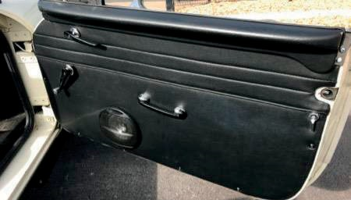
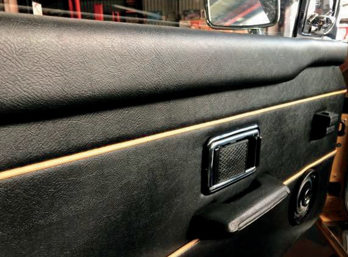
Later door capping
The internal door furniture on the earlier cars consisted of black plastic door pulls in the centre of the doors which were fitted at an angle and a black handle on the top of the door near the front which acted as a door opener, the very early pull handle model also had the interior door lock at the rear of the door to operate the door locking mechanism from inside.
The door locks along with all the connecting rods are specific to the early model with pull handle exterior door openers and were applicable for all cars up to GHN3 57985. The door pull remained the same from 1962 until 1972 and at this date, a more robust plastic version was fitted which was shared with the MG Midget, which had two plastic caps covering the fastening screws. From 1974 the bigger armrest style interior door pull was adopted which was large and plastic covered and had two large screws discreetly hidden on the underside fastening it to the door.
This final style stayed with the MGB and was offered in the same colour as the interior trim until 1976 when it was rolled out as standard black as per most of the interior trim kits, some suggest that this style of door pull also doubles as an armrest with it being that much larger, padded and at a comfortable level to rest on whilst driving.
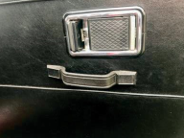
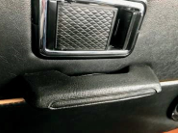
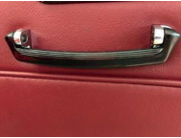
Different Door pulls
The window winder handle sat below the door opener and operated the window winder mechanism which also changed three times during production, the first style window regulator was used on the pull handle model then altered slightly for the push button door, but with the same interior winder handle design and fitment, then finally onto the final change when the winder handle was fitted with a new flatter handle which stayed for the rest of production. The Roadster and GT regulators were slightly different lengths to accommodate the different sizes of glass they operated, as the GT door glass was taller.
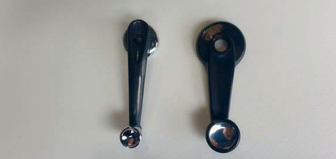
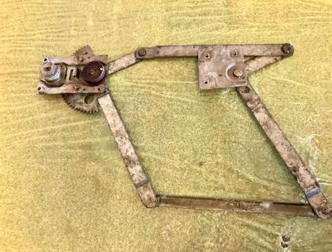
Seat Belts
At first seat belts were not a legal requirement and most cars of the era were not fitted with life-saving safety equipment like they are today. They were offered as an optional extra by the dealers, not factory-fitted items, it is believed all cars had the mountings for the seat belts to be installed. The first style of seat belts was a basic static design with no retractable option they simply laid across your shoulder and if not adjusted correctly they simply fell down the side of your arm and did restricting your movement so never really that popular with buyers.
They mounted on fixing points to the rear wheel arch and to a strong mounting section on the inner sill, the very early cars had two 5/16 studs protruding from the wheel arch for the seat belts to mount to. The third mounting was attached to a strong captive nut built into the gearbox tunnel. It has been claimed that some early North American cars only had the option for lap belts as no mountings were fitted to the wheel arches.
The mounting on the wheel arch was altered to a more robust style with a captive nut used, it fitted lower down on the wheel arch. The 3-point seat belts were offered in the same style up to the 1970 model when the rear mounting was moved on the 1971 model cars from the wheel arch to the rear deck area. This style found its way onto the North American cars a little earlier and was fitted on the MK11 version. This caused several issues, as it had to be removed each time the hood was put down and also if a tonneau cover was fitted it became a fiddly affair. It was down to the user to make sure it was clipped incorrectly and having detachable seat belts never really took off for obvious reasons. The style lasted for quite a few years though but finally, inertia reel seat belts became standard on all Roadster cars in 1977. The MGB GT however had the option of inertia reel belts much earlier instead of the static ones and were supplied by Kangol, see image below.
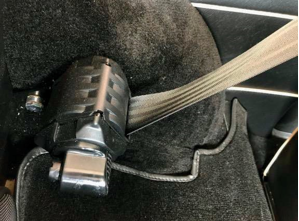
Retractable Seat Belt Unit
Interior dashboard lights
The word interior light can be used but in reality, the lights fitted inside the MGB were more map reading lights, the first cars had them installed on the dashboard on the left (on RHD cars) and just about illuminated something if you were attempting to read a map or something similar (no satellite navigation back then).
This was the only interior light on the MGB Roadster which had the earlier flick-switch dashboard so was used from 1962 – 1971. A boot light was fitted on the Roadster from 1970 that sat underneath the rear deck area inside the boot and was operated by a switch attached to the body and activated when the boot lid was opened.

Early-style dashboard light
The layout of the rocker switch dashboard allowed for a bigger interior light on the centre console which was used from 1972 – 1976 and could be operated either by a switch in the top of the light or by a pin switch on the door shuts, so it was activated as a courtesy light when the doors opened.
The interior light on the North American cars was the same for the MK1 model with the flick-switch style dashboard but when the recessed padded dash was used the light moved to the centre console similar to the UK version.
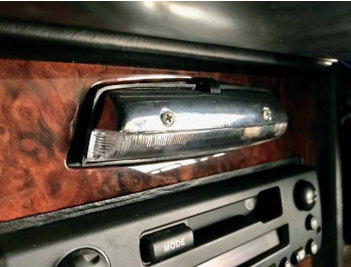
Centre console light
The final Interior dash light was on the 1976 onwards cars when the final dashboard appeared, this was a more plastic offering that suited the dash layout, but gone were the pretty chrome effect covers, and in came a round map-style lamp again.
The MGB GT did have an extra interior light fitted on the rear trim roof section from November 1967 from cars GHD4 139472 which helped shed some light on the interior and rear boot area.
